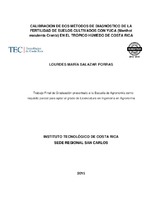Mostrar el registro sencillo del ítem
Calibración de dos métodos de diagnóstico de la fertilidad de suelos cultivados con yuca (Manihot esculenta Crantz)en el trópico húmedo de Costa Rica
| dc.contributor.author | Salazar-Porras, Lourdes María | |
| dc.date.accessioned | 2016-06-10T16:39:27Z | |
| dc.date.available | 2016-06-10T16:39:27Z | |
| dc.date.issued | 2015 | |
| dc.identifier.uri | https://hdl.handle.net/2238/6465 | |
| dc.description | Proyecto de graduación (Licenciatura en Ingeniería en Agronomía) Instituto Tecnológico de Costa Rica. Escuela de Ingeniería en Agronomía, 2015 | es |
| dc.description.abstract | The main objective of this study was to calibrate diagnostic methods of soil fertility KCl-modified Olsen and Mehlich 3, soils cultivated with cassava (Manihot esculenta Crantz). 12 lots located in the humid tropics of Costa Rica, cultivated varieties MBRA 383, Valencia and Miss to harvest age were sampled. From each sampling site were extracted four plants and a sample of soil composed of several subsamples of 0-30 cm depth. Each plant was separated in leaves, stems and roots, three floors of each place analysis them the leaf of each of its parts. 12 soil samples three times with each extracting solution were analyzed to determine the content of nutrients in the soil, each repetition was done on different days with the respective calibration analysis team. The results were analyzed in the spreadsheet Microsoft Oficce Excel 2013. solution Mehlich 3 extracts a greater quantity of Ca, Mg, K, Cu, Mn, Fe and Zn that the binomial KCl-modified Olsen, in the different sites sampled. The amounts of Ca, Mg, K, Cu, Mn and Zn obtained with the extraction solutions showed highly significant correlations (p-value <0.001), the amounts of Fe were significant with a confidence of 95% (p-value <0, 05) correlating the amounts of phosphorus extracted with Olsen mod solutions and ME 3 were not significant. Only obtained linear correlations significant when comparing the chemical extraction of Mn with the concentration of Mn stem, when comparing the chemical extraction of Zn with Mehlich 3 with the concentration of Zn in leaves and to compare the chemical extraction of Zn with Olsen modified with the concentration of Zn in stems. We could not determine critical levels for the cultivation of cassava with the extractants studied, because the dispersion of the points of absolute performance with respect to the concentration of nutrients in the sampling sites showed little variability, which did not allow the proper application of graphical method Cate and Nelson. On average to produce a ton of fresh cassava roots, crop extracts during the entire 4,69 kg N; 1,75 kg of Ca; 0,85 kg Mg; 4,74 kg of K; 0,36 kg of P; 0,05 kg of Cu; 0,26 kg Mn; 0,55 kg of Fe and Zn 0,24 kg. | es |
| dc.language.iso | spa | es |
| dc.publisher | Instituto Tecnológico de Costa Rica | es |
| dc.rights | acceso abierto | es |
| dc.rights.uri | https://creativecommons.org/licenses/by-nc-nd/3.0/cr/ | * |
| dc.subject | Suelos | es |
| dc.subject | Rendimiento | es |
| dc.subject | Manihot esculenta | es |
| dc.subject | KCl-Olsen | es |
| dc.subject | Mehlich 3 | es |
| dc.subject | Absorción de nutrimentos | es |
| dc.title | Calibración de dos métodos de diagnóstico de la fertilidad de suelos cultivados con yuca (Manihot esculenta Crantz)en el trópico húmedo de Costa Rica | es |
| dc.type | proyecto fin de carrera | es |



